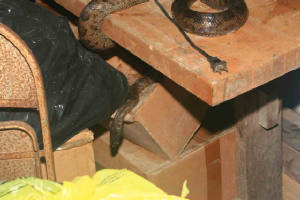|

Rare and protected, the Caribbean boa is desired around the home to control mice and rats. Anyone who has a photo of
one, send me your photo (scan and e mail it or send it to me via normal mail) and I will show it here with photo credit
to you.
Here, all photos shop by Robin Phillips.
The Puerto Rican Boa
is one of the three families of snakes that exist on the island of Puerto Rico. It has a unique head shape and disorderly
scale arrangement.
It is the largest native species of snake and typically
grows to a length of 6 or 7 feet, although 12 foot long specimens have been reported. The Boa's color varies from tan to dark
brown with 70 to 80 crossbars or spots which are outlined in very dark brown.
The boa feeds on rats,
mice and bats. When very young its feeding is limited to small lizards, insects and other invertebrates. Non-poisonous, they
kill their prey by asphyxiating them with the powerful coils of their body. It is not known whether the Boa can kill the agile
Mongoose, but allegedly, the Mongoose does not cause a serious threat to the Boa population.
The boa may be found
on the ground or in trees. In some areas of the forest the Boa hangs from branches, vines and rock ledges at the mouths of
caves and when bats brush by them or collide with them they capture and eat them. Not easily seen in the forest, they have been encountered during daylight hours stretched out on a tree branch near
Yokahu tower.
Baby boa.
Being held only to remove it from a road (where it was almost hit by a car), the boa is released in the jungle where
it climbs a tree.
REASONS FOR CURRENT STATUS: Historical records dating
back to the 17OO's indicate that the boa was relatively abundant until it was
killed for its oil that was exported. To make things worse. its habitat was cut back from tree cutting and housing developments.
Eventually an expedition from the U.S. Natural Museum visited Puerto Rico in 19OO to try and catch one but the boa had become so rare that no specimens could be collected. It's possible that the mongoose, introduced into Puerto Rico in the 19OO's, has further
lowered the boas population but there is no direct evidence to support this idea.
|




